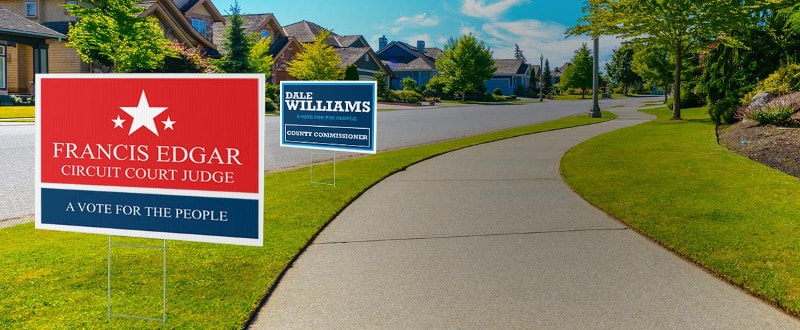Keeping your Yard Sign Campaign Legal
Yard Signs are a critical form of your campaign, offering ongoing advertising and name recognition to your supporters and potential voters. How and where you place your yard signs, however, is a critical step to your success. Your supporters will want to place your signs on roadsides and high traffic areas to increase visibility and support for your campaign, but if you and by extension, our campaign leaders aren’t aware of the state laws you could find yourself in serious trouble- and paying for it out of your pockets.
General Guidelines & Federal Law
While laws change from state to state you will find generally speaking that all states have rules to enforce the placement of signs for aesthetic reasons, safety, and traffic. It’s also fairly common that a disclaimer is present on your signage, disclosing which political party your sign is in support of. You may also find that state law requires signage to remain a set distance from polling stations, to keep candidates fairly campaigning.
The provisions of 23 CFR 750.704 also known as the Federal Highway Beautification Act states that it is illegal to post political signs within 660 feet of the edge of the right of way of an Interstate of Federal Aid Primary System Highway. However, in rural areas signs should not viewable from the Interstate or Primary Highway, even if they are more than 660 feet away. You will find State Governments typically are fairly stringent, as it is a condition for receiving millions in revenue for the highway system.
In addition to this, 11 CFR 1 10.11 or 2 U.S.C 441d states candidates are may be running for federal offices such as President, U.S. Senate or House of Representatives must print a disclaimer on all of their campaign signage. So long as the signs are funded by the candidate’s official committee, the disclaimer must state “Paid for by [name of candidate committee].” In the event, the sign is paid for by a different party or group but is authorized by the candidate the disclaimer must identify who pays for the sign and state that it is authorized by the candidate or committee. In addition, in the event the candidate does not authorize or pay for the sign, the disclaimer must contain the name, permanent street address, and phone number, or web address of the responsible party and explain plainly that the sign was not authorized by the candidate or their committee. Regardless, the disclaimer must be surrounded by a box and the text printed cleanly. We do suggest checking the statute for additional details on font size and such.
Private Property & You
Typically there aren’t many laws restricting what signs are placed on private property, assuming the landowner agrees to what is being placed on their property. Some local governments and homeowner associations will limit the time that a political sign can be on a lawn or ban them all together. In some cases, such as Texas have prohibited homeowners associations from limiting property owner’s ability to display yard signs on their lawn, many homeowners associations have restrictions on outdoor signage, which would include yard signs.
State Laws on Political Signs
Below is a list of the 50 states and links to their targeted state laws. Keep in mind this list may become outdated over time, and the author of this article is not a Lawyer. However, you should be able to gather a great wealth of information to get your campaign started.
- Alabama
- Alaska
- Arizona
- Arkansas
- California
- Colorado
- Connecticut
- Delaware
- Florida
- Georgia
- Hawaii
- Idaho
- Illinois
- Indiana
- Iowa
- Kansas
- Kentucky
- Louisiana
- Maine
- Maryland
- Massachusetts
- Michigan
- Minnesota
- Mississippi
- Missouri
- Montana
- Nebraska
- Nevada
- New Hampshire
- New Jersey
- New Mexico
- New York
- North Carolina
- North Dakota
- Ohio
- Oklahoma
- Oregon
- Pennsylvania
- Rhode Island
- South Carolina
- South Dakota
- Tennessee
- Texas
- Utah
- Vermont
- Virginia
- Washington
- West Virginia
- Wisconsin
- Wyoming







